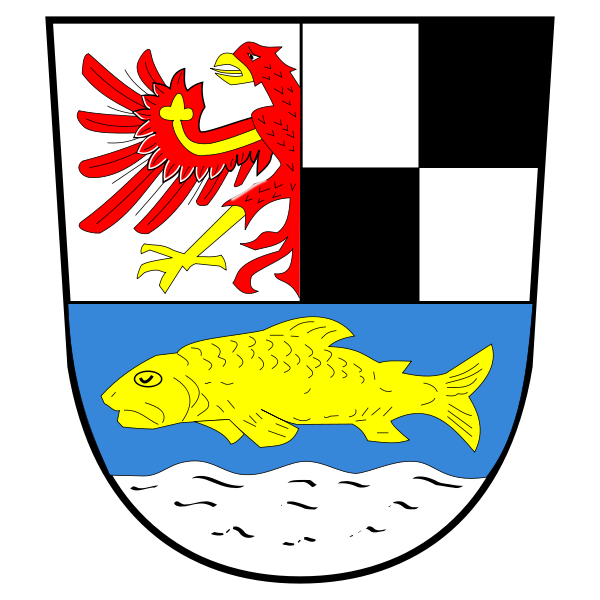_09.jpg)
Marian Baran ID Card
Liberated from Buchenwald Concentration Camp
(klicken um zu vergrößern/click to enlarge)


WELCOME Introduction History Exhibit Displays Visit Pegnitz' Jewish Residents Jewish Committee Property Pflaum Letter ♯♯♯♯♯♯♯♯♯♯♯♯♯♯♯♯

After the end of the Second World War, around 80 citizens of the Jewish faith lived in Pegnitz between 1945 and 1950 - they formed the 'Jewish DP [Displaced Persons] Community Pegnitz'. They had survived the Holocaust in the ghettos and concentration and extermination camps. Some managed to escape.
The Jewish community also had a board, the 'Jewish Committee Pegnitz', chaired by Viktor Klein, who owned a leather wholesale business in Pegnitz.
The exhibition deals with the questions:
The best-known Jewish citizen of Pegnitz is, of course, David Minkowski, who together with his wife Herta, ran the legendary 'Kaufhaus Minkowski' in Rosengasse. However, he belonged to the Jewish DP community Pottenstein and only came to Pegnitz after 1950.
After denazification, some Jews took over Pegnitz businesses as so-called trustees, such as the Wiesend family's quarry or the roof tile and cement goods factory on Buchauer Strasse.
Moritz Werdigier was born in 1908 in Sossnowitz in the Silesian Voivodeship. He survived Auschwitz and Ebensee Concentration Camps; Ebensee was a subcamp of Mauthausen. Having survived the Holocaust, Moritz moved to Pegnitz and became the owner of the roof tile and cement goods factory in Pegnitz. After leaving Pegnitz (he lived there from 1945 to 1949), Moritz lived in Vienna with his wife Edith and son Wolf. Wolf Werdigier, born in Pegnitz in 1946, now lives in Vienna as an international artist.
Let's take a closer look at some other Jewish families in Pegnitz: Mendel Feldbrüll was born on May 10, 1921 in Gleiwitz, Silesian Voivodeship. As an inmate of the Buchenwald Concentration Camp, he had survived the Holocaust. After the war, from 1945 to 1948, he found a new home in Pegnitz with his wife Mila. He worked here as a locksmith, as can also be read in the 1948 directory. In 1948 their son Lewek was born in nearby Bayreuth. A little later, the Feldbrüll family emigrated to the USA - their new home was now called San Francisco. Mendel (or Moniek) Feldbrüll now became Martin Feldbrill. Son Lewek Feldbrüll - later Leon Feldbrill - worked as a dentist in San Francisco.
Abraham Tusk was born on December 25, 1921 in Pabianice, Lodz Voivodeship. He had survived the Holocaust in the Lodz Ghetto (renamed 'Litzmannstadt' by the Nazis). As a trained saddler, he also worked in this profession in Pegnitz. Like so many, he and his family were drawn to the United States; the Tusk family settled in New York. Children and grandchildren were born, but their son Pinkus had already seen the light of day in Bayreuth in 1947.
Felix Plawner was born on October 1, 1920 in Grodziec, Opole Voivodeship. He survived the Auschwitz Concentration Camp and temporarily found a new home in Pegnitz, together with his wife Rosa Plawner née Cymberknopf, and his two brothers Cudek and Karl. Felix worked as a civil servant in Pegnitz, Karl owned a general store in Gößweinstein, and Cudek was the manager of six agricultural schools in the Pegnitz area. Felix Plawner emigrated to the USA with his wife and two daughters where they found a new home in New Jersey. Daughter Hanna was born in Bayreuth in 1947 and later made a career for herself in her new home country.
Jewish families who found a short-term home in Pegnitz after the end of World War II: Altman, Baran, Belach, Braines, Cymberknopf, Danilak, Feldbrüll, Fischer, Galperin, Gelbard, Goldfarb, Goldmann, Gutman, Ickowicz, Klein, Lapides, Lewin, Mendlewicz, Milstein, Monka, Morgenstern, Niegoslawska, Plawner, Podbereski, Prengler, Rabinowicz, Redlic, Reichbart, Reicher, Rosenthal, Satler, Schulz, Silberstein, Tabakman, Teich, Tenenbaum, Tusk, Weisberg, Werdigier, Wroblewski, Zahler, Zelichowska, Zielonykwiat David Minkowski only came to Pegnitz from Pottenstein after 1950. In addition, the following were not registered in Pegnitz, but found work there: Feder (Fedorczuk), Frenk, Friedmann, Goldblum, and Lubowski
Nothing is known about Jewish families in Pegnitz before World War II. You have to go back to the late Middle Ages to find Jewish life in the Pegnitz area. It is known that there was a Jewish cemetery near Rosenhof. In addition to the biographies mentioned here, the exhibit's numerous wall panels and showcases illustrate the life of almost all citizens of the Jewish faith who lived in Pegnitz for a short time.
Unfortunately, the current war in Ukraine, racism, and genocide determine the daily news. Refugees and displaced people are still with us.
Kontakt (Contact): Andreas Bayerlein, Hauptstraße 37, 91257 Pegnitz, Tel. 09241 72326, Mail andreas.bayerlein@stadt-pegnitz.de